March 2005
People Before Profit
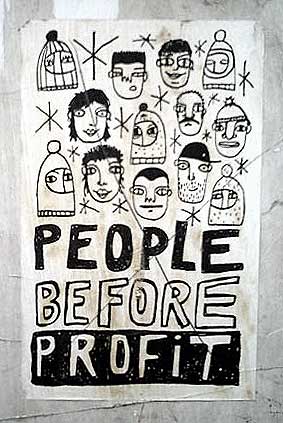
We’re not just against, we’re for!
Spotted somwhere in the 18th arrondissement.
The Great Seal
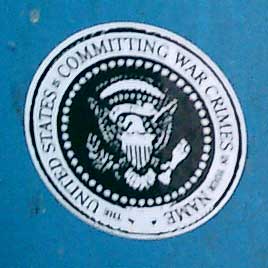
Spotted at North 7th street and Bedford Ave, Brooklyn
The Revloution Begins in Kyrgyzstan
Protestors are occupying government buildings, have taken over an airport, and set fire to a police station.
Taring Padi
Taring Padi in Bahasa Indonesia refers to the sharp tip, or “teeth,” of the rice plant. For the members of the Taring Padi Artists collective it is a metaphor for people power.
Fragments of the old Taring Padi Web site live on in the Internet Archive:
“taring padi is an independent non-profit cultural community which is based on the concept people’s culture. taring padi is committed to using its artistic and cultural pursuits to contribute actively to the democratisation process in indonesia and elsewhere. taring padi will continue to struggle for social justice and liberation from oppression for all peoples, and the environment.”
The collective creates posters and murals, publishes a newsletter, and participates in street performance with puppets, poetry, and musical groups.
From Inside Indonesia:
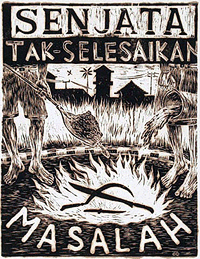 “Yogyakarta [a city in central Java] is renowned historically as a centre for radical cultural protest, particularly in the visual arts. Radical Yogya artists have embraced anti-colonial and revolutionary causes since early in the twentieth century. Like their predecessors, Taring Padi artists promote the concept of people’s art - seni kerakyatan — a loose term that defines the artist’s social commitment and popular orientation. Taring Padi attempt to put this credo into practise through concrete action, rather than just aesthetic empathy for the plight of the ‘oppressed masses.’
“Yogyakarta [a city in central Java] is renowned historically as a centre for radical cultural protest, particularly in the visual arts. Radical Yogya artists have embraced anti-colonial and revolutionary causes since early in the twentieth century. Like their predecessors, Taring Padi artists promote the concept of people’s art - seni kerakyatan — a loose term that defines the artist’s social commitment and popular orientation. Taring Padi attempt to put this credo into practise through concrete action, rather than just aesthetic empathy for the plight of the ‘oppressed masses.’
Mainstream art, the conventional system of curators, galleries and art collectors, is something Taring Padi avoid. Rather, they cultivate relations with other progressive organisations including students, farmers, and the urban poor. Such was the case for the World Food Day action, when Taring Padi collaborated with Mbah Seko and his group of organic farmers called Petani Lestari (Conservation Farmers), as well as with activists from the environmental non-government organisation Keliling. At the demonstration, activists shared out the protest wayangamong themselves. The cast of wayang figures symbolised the various ‘actors’ involved in the pesticide ‘drama’....
In the period before the June 1999 elections, a number of Indonesian cities experienced heightened unrest. Political commentators predicted ‘civil war,’ and the media fuelled the volatile pre-election atmosphere by nurturing perceived religious, ethnic and racial tensions. As a response, Taring Padi began to produce a series of woodcut posters which carried messages promoting solidarity and peaceful social interrelations. Between March and June 1999, they distributed approximately 10,000 woodcut posters throughout major cities in Java, Sumatra and South Sulawesi. The woodcuts, hand-printed on draft paper, were pasted on city streets, on churches and mosques, on village notice boards, in food stalls, in market places.
Among their other artwork, Taring Padi issue a popular pamphlet called The People’s Trumpet. A series of banners and murals resemble the work of Mexican muralist Diego Riviera. Taring Padi banners are often commissioned by other organisations. The women’s division of the National Human Rights Commission ordered a series of them. Titled The evacuation, the banners depict the harsh realities of the refugee crisis in Aceh by focusing on women’s daily struggles.
![]() But Taring Padi also use banners and murals for community purposes, and invite local people to be part of the painting process. Taring Padi’s creative ethos involves a collective, process-oriented production of artwork. They want to eliminate illusive notions of the artist as ‘genius’ or ‘eccentric’ individual, and of the artwork as somehow ‘sacred.’ Taring Padi artwork does not carry recognition of the ‘individual’ artistic creator. It is stamped instead with the Taring Padi ‘kerakyatan’ insignia — a sprig of rice, red star and cogwheel.”
But Taring Padi also use banners and murals for community purposes, and invite local people to be part of the painting process. Taring Padi’s creative ethos involves a collective, process-oriented production of artwork. They want to eliminate illusive notions of the artist as ‘genius’ or ‘eccentric’ individual, and of the artwork as somehow ‘sacred.’ Taring Padi artwork does not carry recognition of the ‘individual’ artistic creator. It is stamped instead with the Taring Padi ‘kerakyatan’ insignia — a sprig of rice, red star and cogwheel.”
See a collection of linocut prints and paintings.
Over There
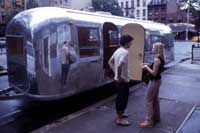 A cousin is in town selling ceramics out of an old jet stream he converted into a nomadic gallery. The Museum of Art and Design (formerly the Crafts Museum) across from the Museum of Modern Art helped arrange a parking space and circulated a press release. This brought New York One, a local cable news channel, to the scene where they filmed a bit in the morning to broadcast a brief story shortly after.
A cousin is in town selling ceramics out of an old jet stream he converted into a nomadic gallery. The Museum of Art and Design (formerly the Crafts Museum) across from the Museum of Modern Art helped arrange a parking space and circulated a press release. This brought New York One, a local cable news channel, to the scene where they filmed a bit in the morning to broadcast a brief story shortly after.
Later that day, passersby gush at the site of the trailer, “Hey! I saw you on the news!”
Their surprise surprises me. If the news supposed to tell us what’s going on, why the surprise when one actually encounters it? Is it just the happy recognition of a celebrity spotting? Or something else? Does the mainstream media, which supposedly shows you the world, also disconnect you from it? Aside from the weather, is the news is always happening somewhere else to someone else?
Central Heating
 One of the few redeeming qualities of winter in New York City are those beautiful columns of steam that rise from the streets. Walking along, you catch these great clouds of vapor churning and billowing — particularly at twilight, through the headlights and street lights.
One of the few redeeming qualities of winter in New York City are those beautiful columns of steam that rise from the streets. Walking along, you catch these great clouds of vapor churning and billowing — particularly at twilight, through the headlights and street lights.
So what’s it all about?
Under the streets of New York City is the largest steam distribution system in the world.
On March 3, 1882, the first steam distribution plant of importance in the U.S. made its first distribution of steam from a central plant at to the United Bank Building on Broadway, sending steam to heat buildings in lower Manhattan.
The New York Steam Corporation, formed July 26, 1880, consolidated with the Steam Heating and Power Company of New York in September 1881. The company was sold in 1915, but when the parent company went bankrupt two years later it was reorganized as the New York Steam Corporation. It was merged into the Consolidated Edison system in the 1930s.
This article from the Gotham Gazette’s infrastructure series draws the broad contours of the current steam system.
Seven steam plants, five in Manhattan and one each in Queens and Brooklyn generate the millions of pounds steam that run under the city’s streets. The steam heats housing, offices, a few churches, and NYC landmarks like the Empire State Building, the Metropolitan Museum of Art, and the United Nations. It is used to press your shirts and in the central sterilization unit St. Vincent’s Hospital. I also note that the system stops south of 96th street.
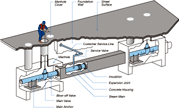 Those plumes in the street may be releasing pressure or perhaps just a leak. The system moves steam at high pressures to maintain the temperature and push it through the system.
Those plumes in the street may be releasing pressure or perhaps just a leak. The system moves steam at high pressures to maintain the temperature and push it through the system.
Three of the plants simultaneously produce both steam and electricity through a process called co-generation. At the height of winter, the system sends out nearly 10 million pounds of steam per hour. Sales from ConEd’s Steam Business Unit account for about 7 percent of total Con Edison revenues.
And because the steam is mass-produced, it is more economical, efficient, and environmentally friendly than the hundred thousand individual oil or gas boilers it replaces. Centralized steam eliminates the need for boilers in individual buildings along with million gallons of heavy fuel oil and traffic from fuel delivery trucks. The steam plants use low sulfur oil or clean-burning natural gas to produce steam. High tech burners further lower nitrogen oxide emissions.
Update 1/9/2010: Here’s a great piece on Urban Omnibus about the NYC steam system.
Troubles
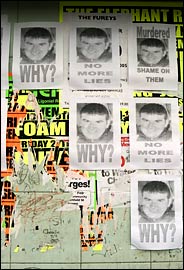 On the topic of posters and terrorism is this piece that ran in the NY Times two days ago about a growing backlash among Catholics to the violence of the Irish Republican Army.
On the topic of posters and terrorism is this piece that ran in the NY Times two days ago about a growing backlash among Catholics to the violence of the Irish Republican Army.
Five sisters are defying intimidation, calling for justice for the murder of their brother and “what is widely seen as a subsequent I.R.A. cover-up.”
As part of the effort, they are posting graphics in the street, both a rallying cry and public defiance of a sector of the community who would silence dissent in the name of the cause.
“Many Catholics in the McCartneys’ neighborhood, a battle-scarred area called the Short Strand, have responded with surprising solidarity.
On the day of the funeral for Mr. McCartney, a popular 33-year-old fork lift operator with two young sons, a thousand people turned up. Graffiti denouncing the I.R.A. popped up on walls, a first in a republican neighborhood; the markings were quickly erased, but quickly reappeared. Small photocopied posters with Mr. McCartney’s photograph appeared on shop windows. ‘No More Lies,’ one said. ‘Shame on Them,’ said another.
Last Sunday, the women held a rally in the neighborhood. Hundreds showed up, including politicians, and several speakers expressed outrage. The sisters held placards that read, ‘Murdered - Who’s Next?’
‘If these men walk free from this, then everyone in Ireland should fear the consequences,’ Paula McCartney, 40, a Queen’s University student, told the crowd, according to news reports. ‘Justice must be done.’”
It is a kind of grassroots resistance to the established resistance, adding further stigma to the violent tactics — from the constituency such tactics are theoretically supposed to benefit.
Still, one has to wonder about the sudden interest of the NY Times in such resistance. The Times is so rarely sympathetic to such activities by left-wing groups. Is it simply the hypocrisy of a righteous group acting less than righteously? Or there another agenda at work? While the I.R.A. may indeed have turned to thuggery (they wouldn’t be the first armed resistance to do so) I suspect a kind of arrogant Statism at play, the sisters provide a convenient proxy to bash those pesky agitators.
Malas Noticias / Bad News
Via email:
“Diseño para la solidaridad / Design for solidarity
 From the 8th to the 11th of March, Madrid welcomes an international summit
on ‘Democracy and Terrorism,’ in honor of the first anniversary of 11M. We
would like to take advantage of this international event so that designers
from different countries and cultures contribute their views and personal
opinions regarding this subject. We have created a virtual gallery and would
like to display in different spaces throughout the city with all the works
that we receive.
From the 8th to the 11th of March, Madrid welcomes an international summit
on ‘Democracy and Terrorism,’ in honor of the first anniversary of 11M. We
would like to take advantage of this international event so that designers
from different countries and cultures contribute their views and personal
opinions regarding this subject. We have created a virtual gallery and would
like to display in different spaces throughout the city with all the works
that we receive.
This is a project for the creation and free distribution of graphic material against terrorism and supporting the victims, on the first anniversary of the 11M terrorist attack in Madrid.
MISSION
This project intends to be a public design forum for the creation of images that express points of view on terrorism and promote public debate.
Bad news/ design for solidarity wants to be a symbol for democratic response and citizen participation, on behalf of designers, against terrorism on the first anniversary of the 11M.
The project is conceived as a space that is open to designers all over the world and comes forth parallel to the conference on "Democracy and Terrorism" that will be celebrated in Madrid in February of 2005.
Bad News/ Design for Solidarity hopes to be a symbol for international solidarity against terrorism. For this we need for you to contribute with your creativity and talent.”
When I received the first email about this, I was skeptical. Posters denouncing terrorism because it’s bad? Isn’t that the method of terrorism?
But when I received the second email I took another look. The inclusion of Reza Alavi’s ‘New Iraqis Flag’ and a poster linking war with Wall Street points towards a more interesting analysis of the subject. And promoting public discussion seems like a good way to go.
Submission details and a current gallery of posters are up at http://unmundofeliz.org.
Now What?

A public conversation on Bowery and 4th Street.
Design Planning for Activists
A few places to start:
- Planning Your Next Conference (855KB PDF)
“This paper is intended to assist organizers in developing successful grassroots/community level conferences within 5 months. It is written from a designer’s perspective to help you complete your tasks for maximum impact and minimum stress.” - Failing By Design: Why Bad Ads Happen to Good Causes (1.9MB PDF)
On layout and messaging. - 14 ways to cut design and production costs (while increasing response)
How to work with print shops. - Public Relations Strategy and Media Relations Tips for Non-Profits and Advocacy Campaigns

